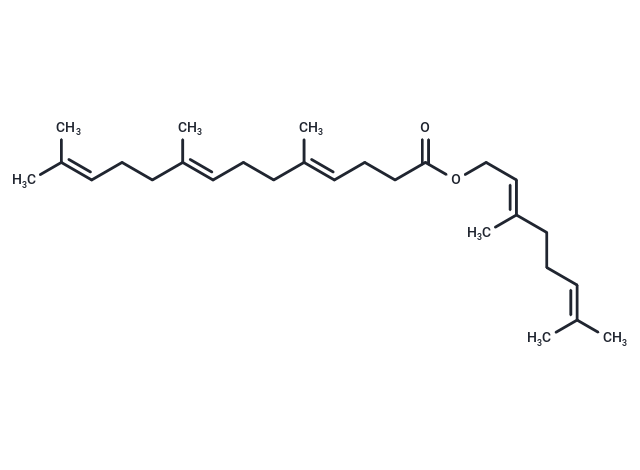Shopping Cart
- Remove All
 Your shopping cart is currently empty
Your shopping cart is currently empty

Gefarnate is a synthetic compound used for the treatment of gastric ulcers,and also used in the treatment of dry eye syndrome.

| Pack Size | Price | Availability | Quantity |
|---|---|---|---|
| 100 mg | $38 | In Stock | |
| 200 mg | $56 | In Stock | |
| 1 mL x 10 mM (in DMSO) | $29 | In Stock |
| Description | Gefarnate is a synthetic compound used for the treatment of gastric ulcers,and also used in the treatment of dry eye syndrome. |
| In vivo | Gefarnate stimulated mucin-like glycoprotein secretion in conjunctival tissue in a dose-dependent manner. In the rabbit dry-eye model, application of gefarnate ointment to the eyes resulted in a dose-dependent decrease in rose bengal permeability in the cornea, with the effect being significant at concentrations of ≥0.3%. In the cat dry-eye model, application of gefarnate ointment resulted in a significant decrease in the corneal fluorescein staining score[1]. |
| Animal Research | Conjunctival tissue isolated from rabbits was treated with gefarnate. Mucin-like glycoprotein was detected in the culture supernatant by an enzyme-linked lectin assay. Gefarnate ointment was topically applied to eyes once daily for 7 days in the rabbit dry-eye model, in which the lacrimal glands, Harderian gland, and nictitating membrane were removed, or for 4 weeks in the cat dry-eye model, in which the lacrimal gland and nictitating membrane were removed. Corneal epithelial damage was evaluated by measurement of corneal permeability by rose bengal in the rabbit model or by fluorescein staining in the cat model[1]. |
| Molecular Weight | 400.64 |
| Formula | C27H44O2 |
| Cas No. | 51-77-4 |
| Smiles | C(=C/CCC(OC/C=C(/CCC=C(C)C)\C)=O)(\CC/C=C(/CCC=C(C)C)\C)/C |
| Relative Density. | 1.31g/cm3 |
| Storage | Powder: -20°C for 3 years | In solvent: -80°C for 1 year | Shipping with blue ice. | |||||||||||||||||||||||||||||||||||
| Solubility Information | DMSO: 100 mg/mL (249.6 mM), Sonication is recommended. | |||||||||||||||||||||||||||||||||||
Solution Preparation Table | ||||||||||||||||||||||||||||||||||||
DMSO
| ||||||||||||||||||||||||||||||||||||

Copyright © 2015-2025 TargetMol Chemicals Inc. All Rights Reserved.